Lithium-Ion batteries occupy a very large place in our lives and their use is increasing day by day. To use these batteries correctly, we need to have some basic knowledge. We will examine Lithium-Ion batteries on a few topics.
1 )Voltage
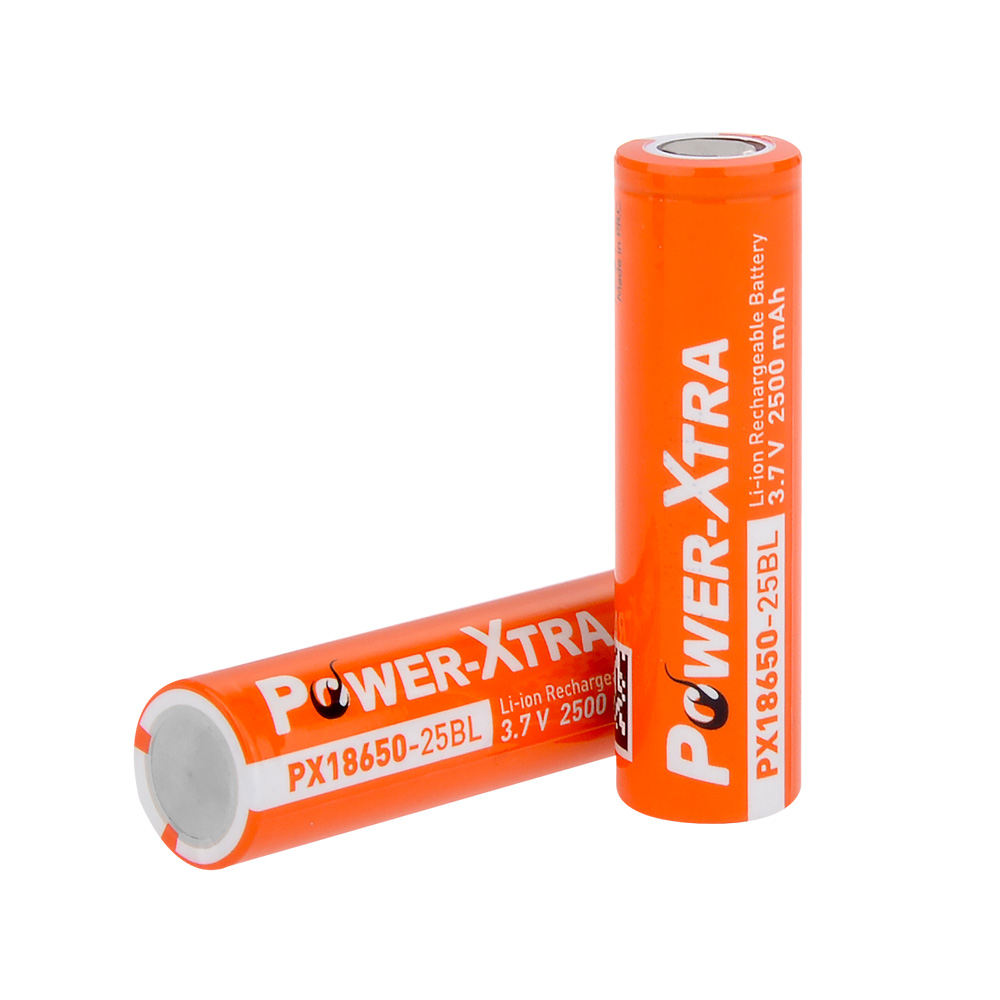
As you can see in the images on the left, values such as 3.6 volts and 3.7 volts are written on the batteries. This shows the nominal assembly of the batteries. Lithium-Ion batteries have a nominal voltage of 3.6 or 3.7 volts. So why is the rated voltage 3.6 volts and what does it mean? For Lithium-Ion batteries, the rated voltage is the average voltage at discharge when fully discharged by the rated discharge current of a fully charged battery. That is, it is the average voltage received over the course of use.

|
When the graph above is examined, the data that emerges when a fully charged 2900 milliampere-hour battery is discharged with 580 milliamperes up to 2.7 volts is seen. As it is understood from this graph, there is no sudden voltage drop, there is a regular trend in the graph curve. Especially around 3.8 - 3.7 - 3.6V, there is a regular flow as much as possible. The slope was less around 3.6 - 3.7V, and the voltage drop was fast after 3.5V. The average voltage across this graph is around 3.6 - 3.7V. Of course, this is valid at rated current. If the current is increased too much, the voltage drop will be sharper. In short, you can consider a series of batteries as 3.6V and calculate your need accordingly. For example, if you need 3 batteries connected in series, it will be 10.8V. 4 batteries connected in series would be 14.4V.
2-) Connection Types
If the batteries are connected in series, the voltage increases, if they are connected in parallel, the capacity increases.
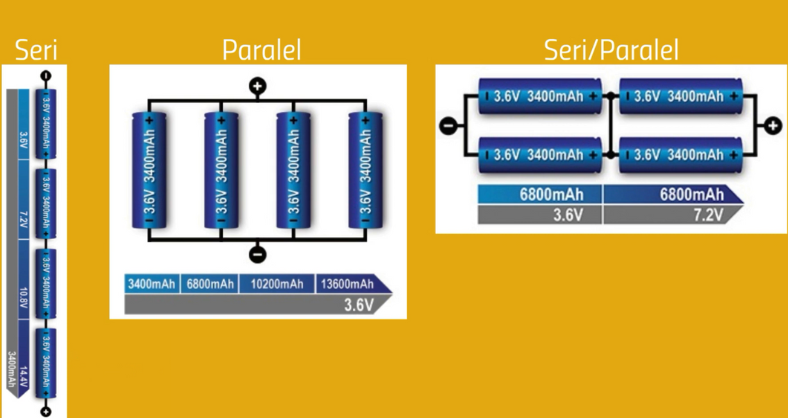
|
If you connect the batteries in series, the voltage will increase. In the first connection in the figure above, 4 batteries of 3.6V 3400mAh are connected in series. As the voltage will increase as the series is connected, a 14.4 volt 3400mAh battery was obtained. If the batteries are connected in parallel, the voltage remains constant and the capacity increases. As can be seen from the figure shown above, 4 batteries were connected in parallel and a 13,600 milliamp hour 3.6 volt battery was obtained. If you want to increase both voltage and capacity, you can make serial and parallel connections. As stated in the last figure above, 2 of the 4 batteries are connected in parallel and they are connected in series with each other. As a result, a 7.2 volt 6.800 mAh battery was obtained.
3-) Capacity
Capacities such as 2500mAh, 2900mAh, 3500mAh are written on the batteries or on the data sheets. This is the capacity that the battery can provide at rated current and under ideal conditions. In test studies, no current is tested to measure the capacity of the battery. All over the world, this business is bound to standards. After the battery is fully charged, it should be tested by being discharged at room temperature and with a current of twenty percent of its capacity. For example, if you have a 3000 milliampere hour battery, you should discharge this battery with 600 milliamperes and wait for it to work for 5 hours. You can calculate the capacity according to the working hours.
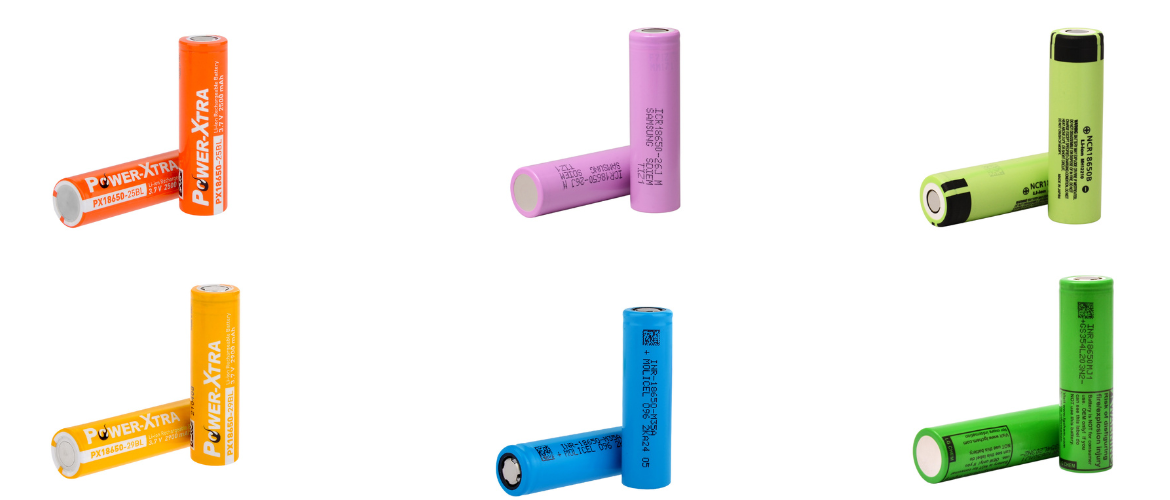
|
There are some batteries in the image above. If you pay attention, some batteries' capacities are written, while others are not. Here are the Power-Xtra 2500mAh, and 2900mAh batteries. Some brands like Samsung do not outline the capacity on the battery, instead, they outline a code. For example, the Samsung 26JM model has a 2600mAh battery, while the Samsung 29E has a 2900mAh battery. Samsung names its batteries by giving shortcodes based on capacity. Brands such as Sony and VTC indicate only brand/model names such as VTC5 and VTC6 on their batteries. We can learn the details of these batteries by looking at the datasheet. These brands generally do not prefer to write the capacity on the battery, they write a code and explain all the features to the customer with this code. In VTC, there is no hint of capacity in the code.
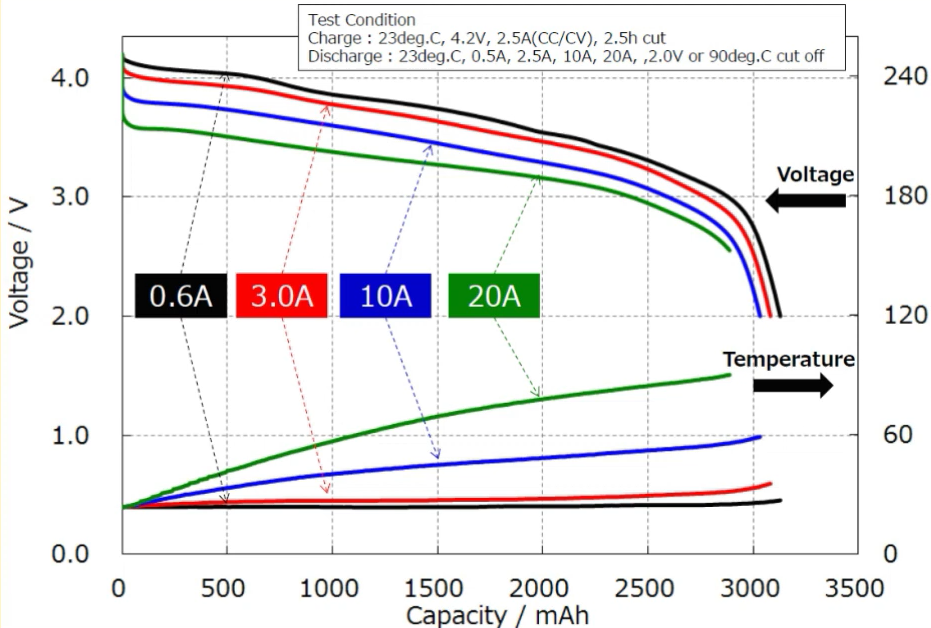 In the graph on the side, the capacity is examined according to the current and temperature. This graphic belongs to Sony VTC6. We mentioned earlier that the VTC6 will provide at least 3000mAh capacity at nominal conditions. When we look at the black curve in the graph, we see that a capacity of over 3000 mAh is obtained when it is discharged with 20% of the capacity (i.e. 600 milliamperes). As the discharge current increased, the capacity naturally decreased. For example, on the chart, less than 3000 mAh of capacity is achieved at 20 amps, which is quite normal. Capacity decreases with distance from ideal conditions.
In the graph on the side, the capacity is examined according to the current and temperature. This graphic belongs to Sony VTC6. We mentioned earlier that the VTC6 will provide at least 3000mAh capacity at nominal conditions. When we look at the black curve in the graph, we see that a capacity of over 3000 mAh is obtained when it is discharged with 20% of the capacity (i.e. 600 milliamperes). As the discharge current increased, the capacity naturally decreased. For example, on the chart, less than 3000 mAh of capacity is achieved at 20 amps, which is quite normal. Capacity decreases with distance from ideal conditions.
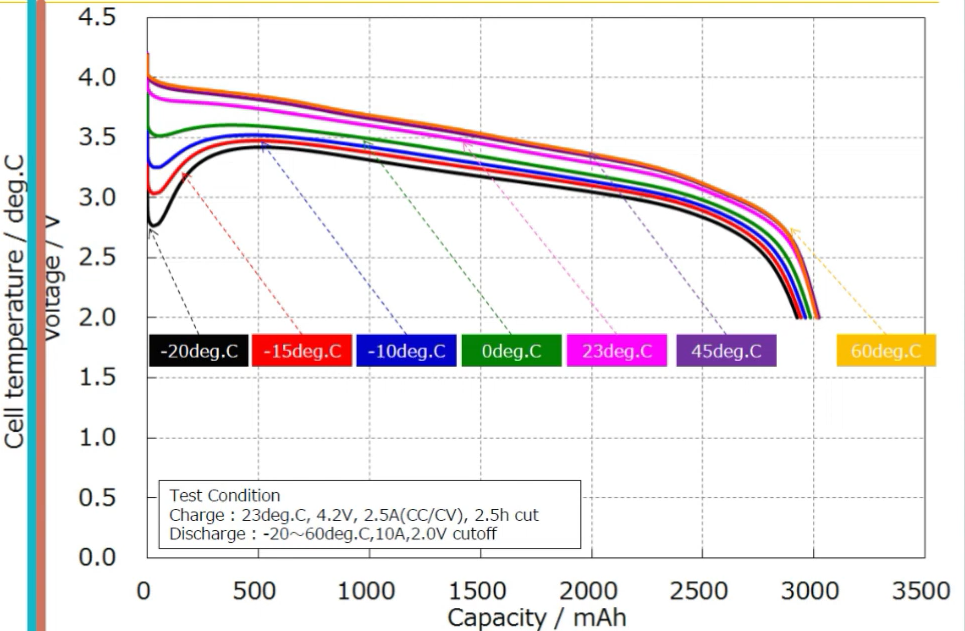 In the graph on the side, the examination was made according to the temperature values. As we mentioned, ideal capacity was obtained at room temperature. This chart is a 10 amp test result. Despite this, a capacity of 3000 mAh was reached at room temperature. But the capacity decreased when the temperature dropped to -15 degrees or -20 degrees. As mentioned earlier, the capacity decreases as you move away from ideal conditions.
In the graph on the side, the examination was made according to the temperature values. As we mentioned, ideal capacity was obtained at room temperature. This chart is a 10 amp test result. Despite this, a capacity of 3000 mAh was reached at room temperature. But the capacity decreased when the temperature dropped to -15 degrees or -20 degrees. As mentioned earlier, the capacity decreases as you move away from ideal conditions.
4-) Current
The current is very confused with the capacitance. Capacity is in amps/hour, which means how much current flows in an hour. Ampere is instantaneous, it is the voltage divided by the resistance. V=I x R is the most basic formula for batteries and electricity (Ohm's Law).
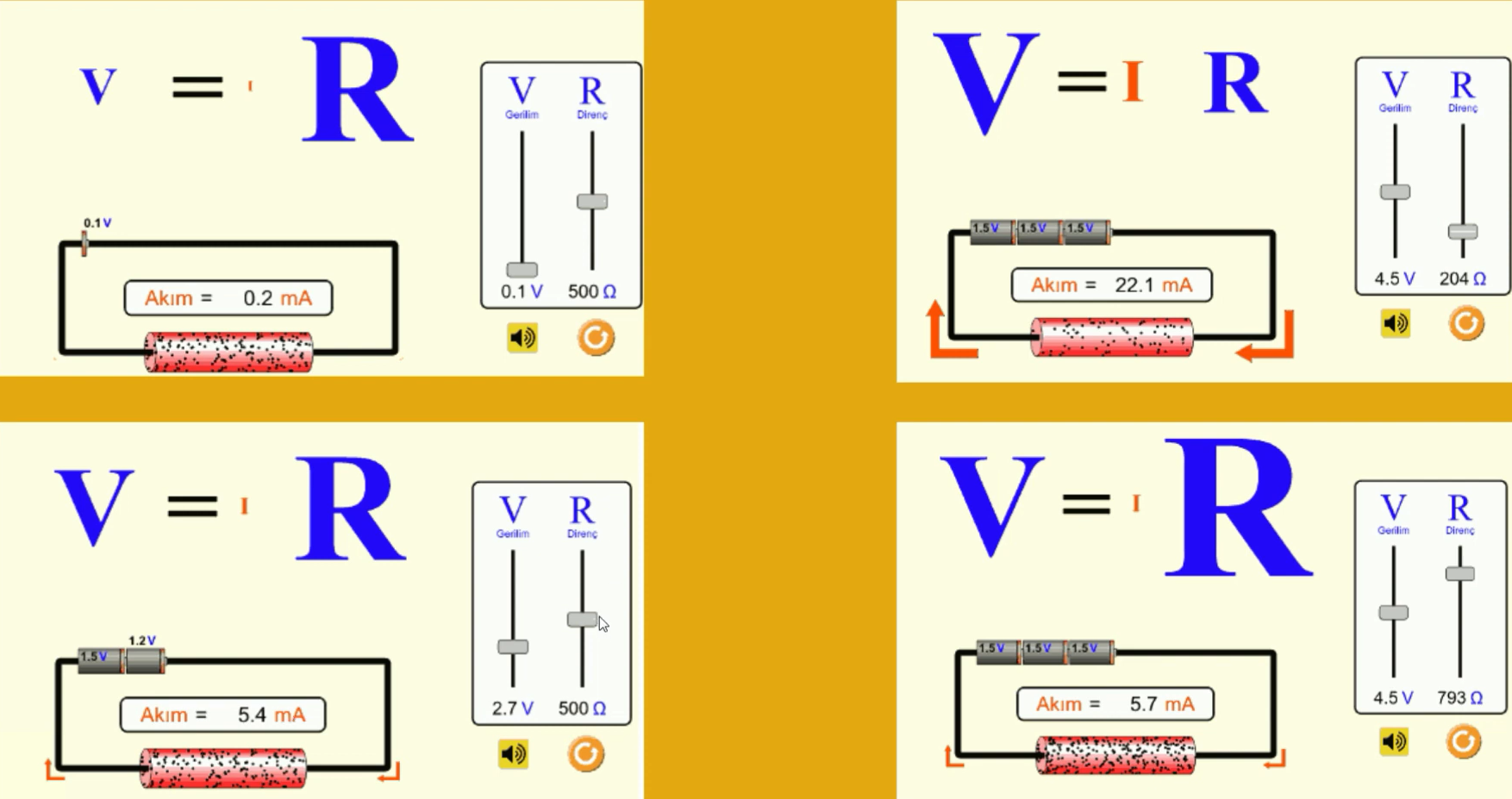
|
There are two different scenarios in the image above. In the first scenario there is a potential difference of 0.1V. Discharged with 500Ω resistor. When 0.1 volt is discharged with 500Ω, 0.2mA is passed. When the voltage is increased while the resistance is fixed, that is, when we discharge the 2.7 volt battery with 500Ω, we see that 5.4 milliamperes is passed through the battery. In other words, as the voltage increases at the same resistance value, the current naturally increases. There is a direct proportion between them. Let's examine what happens if resistance increases in the second scenario. With the voltage steady, 22.1 milliamps passed through our 4.5 volt 204Ω battery. When we increase the resistance while the voltage is constant, 5.7 milliamperes is passed through our battery. So the current decreases. The larger the resistance, the less current can flow. You should know the current and operating voltage that your application will draw and choose the appropriate battery. Not every battery is used in every application.
5-) Charge
The charge voltage of Lithium-Ion batteries is 4.2 volts. Lithium-Ion batteries should be charged by CC-CV method with the help of special chargers. CC-CV stands for constant current-constant voltage. We cannot charge the batteries at the speed we want, the charging current of each battery is different. However, a current of half the capacity is ideal for all Lithium-Ion batteries.
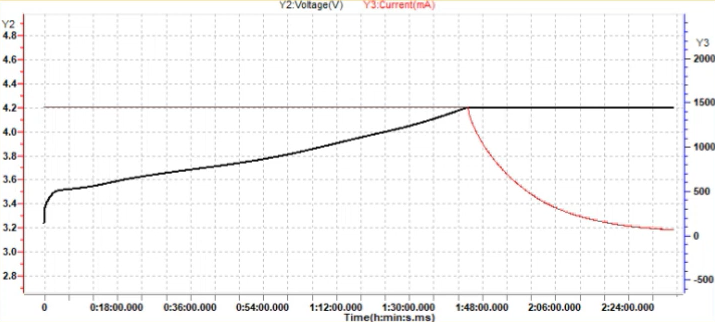
|
In the graph you can see that the 2900 mAh battery is charged with 1450 milliamps. First, the battery is charged with a constant current of 1450 milliamps to 4.2 volts (black graph shows voltage). Then, as soon as the battery reaches 4.2 volts, the voltage is held constant and the charging current drops. The battery is fully charged when the charging current drops to 2% of the battery capacity. This applies to the specified special chargers or for those who want to design their own device. There is no setting for this in chargers on the market. It is not seen how far the current drops in these devices. The device current drops to 70-80 milliamperes, completing the charging process for all batteries. Care should be taken when charging lithium-ion batteries. It should not be charged with any adapter or old nickel-cadmium chargers. These batteries are dangerous as they are flammable and explosive.
6-) Discharge
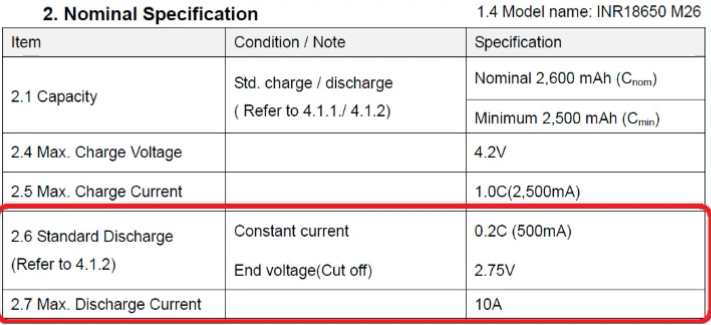
|
The minimum discharge voltage of Lithium-Ion batteries may vary by brand. Usually it is 2.5V-2.7V. The data sheet should be checked for discharge voltage and discharge current. Above is the datasheet of the LG M26 battery. For Sony, this discharge voltage can be 2 volts. For Panasonic it can be 2V-2.5V. LG has given 2.75 volts in this battery model. The standard discharge current is a constant 500 milliamperes, ie 20% of the minimum capacity of the battery. The maximum discharge current is also important to you if you are going to draw slightly more current than the maximum discharge current (which you will not always draw rated current in an application). It says here that it can draw 10 amps. You should not draw 11-12 amps from this battery. It can get very hot, the battery may be damaged. You should draw as much current as recommended. If you need more current, you can use a series that can deliver 20 amps, 30 amps, 35 amps, such as the VTC series. The lower you keep the charge voltage from 4.2, the higher the cycle count of the battery. The higher you keep the discharge voltage above 2.7 volts, the higher it will be. We should not discharge below 2.75, which is stated in the information sheet above, but if we want, we can discharge up to 3 volts or 3.2 volts above it. We used to use 2400 milliamps instead of 2500 milliamps, but if we can use our battery at 600 or 1000 cycles instead of 500 cycles, it will extend its life.
7-) Cycle Life
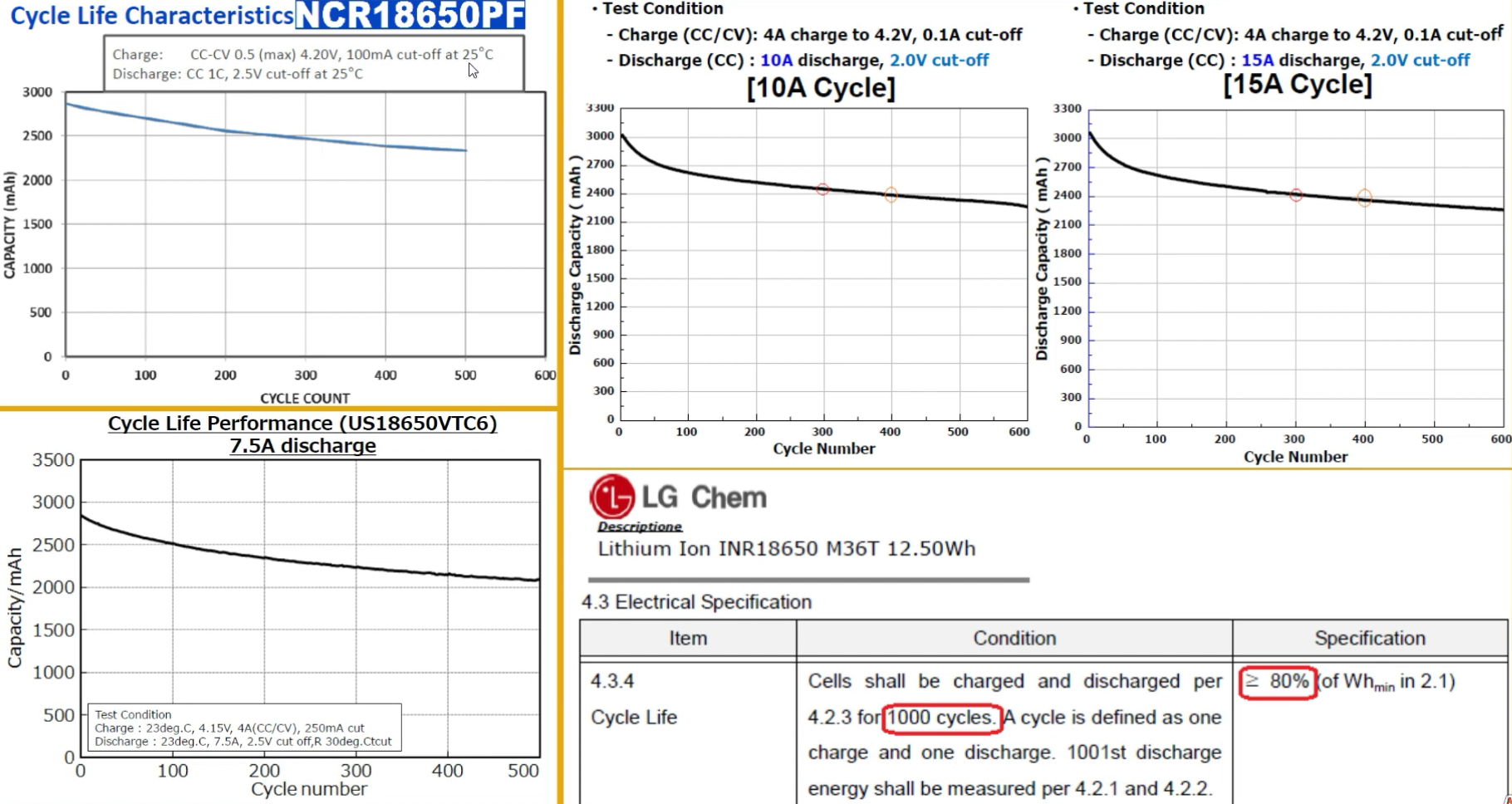
|
Many brands say that when you charge and discharge their batteries 500 times, the battery will drop to 80% capacity. 80% matters because a battery that loses capacity with a fairly smooth curve up to 80% can become unstable after 80%. Cycle life gets shorter as you move away from ideal conditions. In the chart above, the 18650PF was charged at room temperature, i.e. 25 degrees, between 0.5C and 4.2 Volts and discharged at 1C to 2.5 volts. In this case, you will see how much the capacity decreases according to the number of cycles. In the first chart, it is stated that at the end of the 500th cycle, it will decrease to around 2300-2400 mAh. When we examined the graph of the Sony VTC6, it was charged up to 4.15 volts with 4 amps at 23 degrees at room temperature. A maximum temperature of 30 degrees Celsius is allowed in the discharge. It is stated that when discharged up to 7.5 amps and 2.5 volts, the capacity will decrease to around 2100 mAh. In the top right you can see the graph of the two LG batteries. Both were charged under the same conditions. It discharged with 10 amps on the left and was able to deliver over 2400mAh of capacity after 300 uses. The one on the right yielded 2400mAh capacity after 300 uses with 15 amp discharge. That is, the higher the discharge current, the shorter the cycle life. Lithium-Ion batteries usually have a lifespan of 500 cycles. Above you see the LG M36 battery. This battery has a 1000 cycle life, more than that is not possible for Lithium-Ion batteries today. It is possible to reach much higher cycle numbers in various sub-chemistries of Lithium-Ion batteries. For example, LiFePO4 batteries have a cycle life of 2,000. LTO-(Lithium Titanate Battery) batteries have a cycle life of 10,000. Even if you use it every day, it promises a lifespan of about 30 years. However, the energies of these chemicals are low. For this reason, Lithium-Ion batteries are still the best alternative for many applications and the number of cycles is increasing day by day.
If we talk briefly about the storage of lithium batteries; Lithium-Ion batteries should be stored as cold as possible. The ideal storage condition is between 0° - 25° with 40% occupancy. If you store your battery at room temperature with 40% charge, it can maintain its capacity at 96% charge after one year. It is recommended to charge it at least once a year. The higher the occupancy and temperature, the worse it is in terms of storage. For example, if you store it at 100% full and 60°C, you may lose the capacity of your battery irreversibly within three months.
Considering the operating temperature, lithium batteries generally do not charge below 0°. They can be charged from 0° to 45°-50°. Some special batteries allow charging down to -10 degrees. Batteries can be charged at -10 degrees, but this is not recommended for battery health. Discharge temperatures at operating temperatures are slightly wider than charge temperatures. The battery, which is charged at 0 degrees, can be discharged between -20° and 60°. Different brands of batteries can be discharged between -20° and 75°.
For more detailed information about Lithium-Ion batteries, you can follow us and visit our online sales site to purchase.
